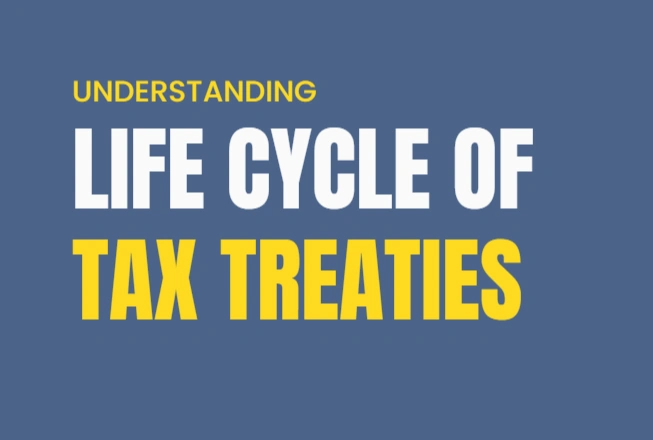UNDERSTANDING LIFE CYCLE OF TAX TREATIES

Excerpt
This article explains the various stages a tax treaty goes through: negotiation, signature, ratification, entry into force and effect, and amendment or termination. It uses examples like the UAE-Kuwait and UAE-Germany DTAAs to illustrate each phase of the treaty life cycle.
Life Cycle of a Tax Treaty

Executive Summary
This article explains the life cycle of a tax treaty, from negotiation to termination, highlighting the key steps and their significance in international tax law.
Introduction
Tax treaties play a crucial role in facilitating cross-border trade and investment, preventing double taxation, and promoting cooperation between countries. Understanding their life cycle helps grasp how international agreements are formed, implemented, and sometimes terminated.
Negotiation
The life cycle begins with negotiation. The two countries engage in preliminary discussions to decide if a tax treaty is desirable, often based on the level of trade and investment between them.
Both parties will share their respective draft - typically based on their preferred model tax treaties, such as the OECD or UN Model - and then proceed to review each article of the treaty in detail.
Provisions on which agreement is not reached immediately may be marked for further discussion. After multiple rounds of negotiation, on achieving consensus on the entire text, the treaty is initialled by the negotiators to signify provisional agreement on its contents.
Signatures
Following initialing, the treaty moves to signature.
The countries arrange a formal signing ceremony, and an authorized high-level official signs the treaty on behalf of each government.

Ratification and Exchange of Instruments
Ratification is the formal process by which a country officially confirms and accepts a treaty, making it legally binding under international law for that country.
After signing, each country must ratify the treaty according to its constitutional procedures.
This typically involves legislative or executive approval: for example, one country's parliament may need to pass a law or the cabinet might issue a decree to approve the treaty.
Once both countries have completed their ratification process, they formally exchange instruments of ratification. The exchange of these instruments signifies that the treaty is conclusively accepted by both sides.
Entry into Force and Entry into Effect
Entry into force refers to the moment the treaty becomes legally binding on the two countries. In the context of OECD/UN Model-based tax treaties (and most actual treaties), generally, exchange of ratification instruments = entry into force - unless the treaty provides for a different mechanism (e.g., entry into force occurs 30 days after the exchange).
Entry into effect is the date starting which the treaty's provisions start to apply to taxpayers and taxable events. A treaty in force may specify that its terms only take effect from the start of the next tax year. Most treaties contain detailed effective date clauses (as a part of the Entry into Force clause).
Below is an example from the UAE-KSA DTAA (where clause 1 is Entry into force and clause 2 is Entry into effect).

Example of a Treaty in Process
Let's take the example of the recently signed UAE-Kuwait DTAA:

Duration and Termination or Modification
Once in force and effective, a tax treaty generally remains in operation indefinitely - there is usually no fixed end date. Instead, treaties include a termination clause outlining how either country can end the agreement.
Termination of tax treaties is not common, as treaties are important for investor confidence. However, it does happen occasionally - for example The UAE-Germany DTAA:
"Article 30(1): This Agreement shall remain in force for a period of ten calendar years beginning on the first day of January of the calendar year next following that in which the Agreement entered into force according to paragraph 2 of Article 29. Thereafter, it shall remain in force for a further ten calendar years if both Contracting States have agreed to a prolongation and informed each other in writing by diplomatic channels, six months before expiry, that the internal requirements for a prolongation are fulfilled..."
Germany decided to not to renew the agreement with the UAE and therefore, UAE's DTAA with Germany expired on December 31, 2021.
Countries may renegotiate or update tax treaties by signing an amending protocol. A protocol is essentially a mini-treaty that modifies certain provisions - it must go through the same life cycle as explained earlier to become applicable and effective.